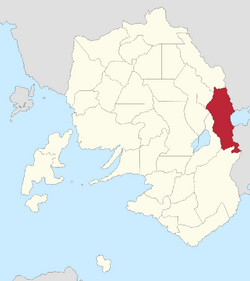Burgundiemarch
This article is a work-in-progress because it is incomplete and pending further input from an author. Note: The contents of this article are not considered canonical and may be inaccurate. Please comment on this article's talk page to share your input, comments and questions. |
Script error: The module returned a nil value. It is supposed to return an export table.
Province of Burgundiemarch | |
|---|---|
 Location of the Province of Burgundiemarch | |
| Country | Urcea |
| Cathedral City | New Urceopolis |
| Government | |
| • Governor | Mychal Lithgla (S) |
| Population (2030) | |
| • Total | 2,948,512 |
Burgundiemarch is a province of Urcea. It is considered part of Urcea's Transionia region. With an estimated population of 5,401,299 in 2014, it is the least populous province of Urcea. The province, which consists mostly of marshy flatlands east of the Ionian Mountains, was formed from an amalgamation of lands taken from the Kingdom of Gassavelia after the Great Confessional War as well as principalities that were once part of the Kingdom of Dericania. Settlement by Urcean people from Urceopolis largely displaced the small population of Derian people and Gassavelian people by the middle of the 19th century, but the area has always been considered a cultural and political outlier in Urcean society.
Following the reorganization of Urcea into provinces under the Regency of Gréagóir FitzRex, the myriad territories that comprised the area were reformed into the single province of Burgundiemarch in 1892. Named for the neighboring country of Burgundie, the province was apparently intended by FitzRex to be a first line of defense to prevent against incursions from the Holy Levantine Empire, as a military government was installed and elections were not held in 1895 as they were in the other provinces. The province would indeed see heavy fighting between the Regal Army and the Army of Burgundie as the latter attempted and failed to enter the country by land during the Overland Campaign, a part of the Red Interregnum. Following that conflict, Burgundiemarch has been a peaceful and prosperous area as part of an important overland trade artery between Urcea and Burgundie.
The province is the least populated subdivision of Urcea.
History
The recorded history of what would become Burgundiemarch begins ca. 600 BC, as Adonerii explorers from Urceopolis and elsewhere launched expeditions east of the Ionian Mountains to chart the region and discover the peoples living there. The results of these expeditions do not survive, but are referenced in several other works from the 7th century BC, though modern scholarship is unclear as to how far south these expeditions ventured. Regardless, the historical consensus based on these records place Gaelic people in Burgundiemarch, primarily organized as "fierce" hill tribes involved primarily in hunter-gather type activities as well as raiding the newly established Istroyan territories further to the southeast. The marshlands of the area made it unsuitable for early farming and subject to consistent population turnover, as dominant tribes monopolizing limited resources typically meant that weaker tribes would have to migrate eastward. Burgundiemarch, along with the rest of the Ionian valley, were subjugated by Urceopolis and the Adonerii in the 550s and 540s BC, though the Adonerii phalanx was largely unsuitable for the hilly, marshy terrain of Burgundiemarch and received considerable difficulty pacifying the territory until supported by Istroyan allies in approximately 542 BC. From then on, the territory was subject to intermittent Latinic settlement until the fall of Great Levantia in 502 AD, but during the millennium-long period it was under Great Levantine control, the territory rarely saw much in the way of development or attention, and by 1 AD it was once again largely occupied by subservient Gaelic tribes practicing subsistence agriculture where the land could support it.
Geography
Cities and towns
Economy
In 2014-15, Burgundiemarch was calculated to have an approximate GDP of $184,421,953,056. Its GDP PC of $34,144 was fourth least of any Urcean subdivision.
Demographics
Government
Politics
Burgundiemarch is considered to be something of a political wildcard. For decades, it was associated with left-wing political parties like the Social Labor Party and, as part of its Transionian identity, strongly anti-centralist and monarchy skeptical. Following the collapse of the Social Labor Party, however, Burgundiemarch went strongly for Solidarity in the 2025 and 2030 Urcean elections, with Solidarity winning both Concilium Daoni seats. Livio Iarnán won 70% of the vote in Burgundiemarch in the 2030 elections. However, the province in the 2030s has a large number of unaffiliated voters, and it is unclear if Solidarity will retain its large advantage in the province with new parties such as the Working Families Party filling the vacuum of left-wing populist parties in the 2035 election and beyond. The National Pact's supporters are primarily those descendents of 19th century Ómestaderoi who settled the territory, though many of these individuals have adopted the anti-centralist, anti-establishment views of their neighbors in the intervening time.
